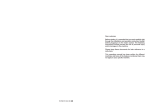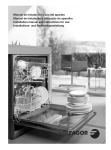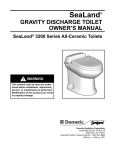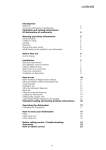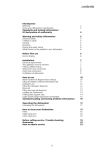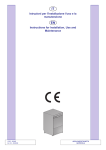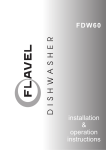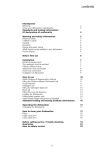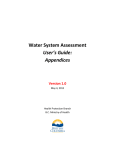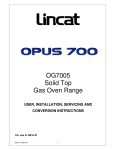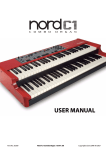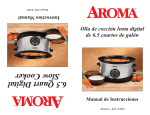Download De Dietrich DVY640JU1 dishwasher
Transcript
INSTRUCTIONS FOR USE DISHWASHER Dear Customer, You have just acquired a DE DIETRICH dishwasher and we would like to thank you. Our research teams have created this new generation of appliances for you. Their quality, design, features and technological advances make them exceptional products, and reveal our unique know-how. Your new DE DIETRICH dishwasher will blend harmoniously into your kitchen and will perfectly combine washing and drying performance and ease of use. We wanted to offer you a product of excellence. In the DE DIETRICH product range, you will also find a wide choice of hobs, ovens, microwaves, hoods, cookers, fridges and freezers that you can coordinate with your new DE DIETRICH dishwasher. Visit our website , www.dedietrich-electromenager.com where you will find our latest innovations as well as useful and complementary information. DE DIETRICH Setting New Values As part of our commitment to constantly improving our products, we reserve the right to make changes to them based on technical advances to their technical and functional features and appearance. Warning : Before installing and using your appliance, please carefully read this Guide to Installation and Use, which will allow you to quickly familiarise yourself with its operation. www.dedietrich-electromenager.com Dear customer, Please read these instructions before installing the dishwasher and using it for the first time. The information contained herein is provided to avoid accident risks and/or damage to your appliance Please keep these instructions in a safe place for your future reference Upper basket Upper spray arm Upper basket rail cap Water softener cap Lower spray arm Lower basket Cutlery basket Filters Detergent and Rinse aid dispenser 1 EN TABLE OF CONTENTS ! ? 1. Section Warning and safety information Electrical safety Childrens safety General Environmental care Unsuitable dishware 3 3 3 4 5 5 2. Section Before first use 6 3. Section Connections Electricity connection Water connection 6 6 7 4. Section Usage Information Water Softener Detergent Rinse - Aid 8 8 10 11 5. Section Loading the Dishwasher Unloading the dishwasher 13 13 6. Section How to clean your machine How to clean the filters How to clean the spray arms 14 14 15 7. Section How to change the place of your dishwashwer 15 8. Section Troubleshooting 16 9.Section Standard and testing information 16 2 EN ! Warnings and Safety Information Electrical safety The dishwasher should be operated under the operating voltage specified. For electrical safety, only earthed plugs and plug sockets should be used. Always use the fused plug provided with the appliance. The user is responsible for meeting these basic safety requirements. The life of your machine and your safety depend on your using an electrical installation compliant to standards. Do not use an extension cable. When disconnecting your machine from the mains supply, always pull from the plug. Never pull the cord itself. Child safety Never allow you children play with your dishwasher. Dishwasher detergents contain irritants and abrasives. These ingredients might have caustic effects in the eyes, mouth and throat. They can be extremely dangerous if swallowed. avoid contact with skin and eyes. Check that the detergent receptacle is empty after completion of the wash cycle. Keep detergents out of childrens reach and do not put detergent in the machine until right before you start the washing program. The water in your dishwasher is not suitable for drinking, for this reason do not allow your children near your machine when the front door is open. Never allow your children play on or sit onto the front door when the front door is open. After unpacking your machine, keep the packing material out of childrens reach. Warning ! The appliance is not intended for use by young children or infirm persons without supervision. 3 EN ! Warnings and Safety Information General This dishwasher has been designed to clean your dirty dishes at home. Never use chemical solvents in your machine; this may lead to explosion risk. Never use materials other than specially produced softening salts in the salt container of your machine. Never use materials other than specially produced detergents and rinse-aids in the detergent and rinseaid containers of your machine. When you want to change the position of your machine, follow all the warnings mentioned in this section after making sure that the machine is empty. Please dispose of packaging material and old appliances carefully. Please ensure old machines do not become a threat to child safety. It is known that children lock themselves in unused machines. To avoid such a problem it is advised that you cut the mains cable off and break the door latch so it does not lock. The door of your machine is designed to support the weight of a full basket when the lower basket is pulled all the way out. Never place any other load on the door, otherwise the machine may tip over. 4 EN ! Warnings and Safety Information Environmental Protection Recycling This appliance's packaging material is recyclable. Help recycle it and protect the environment by dropping it off in the municipal receptacles provided for this purpose. Your appliance also contains a great amount of recyclable material. It is marked with this label to indicate the used appliances that should not be mixed with other waste. This way, the appliance recycling organised by your manufacturer will be done under the best possible conditions, in compliance with European Directive 2002/96/EC on Waste Electrical and Electronic Equipment. Contact your town hall or your retailer for the used appliance collection points closest to your home. We thank you doing your part to protect the environment. Energy and water saving Remove the food remains (bones, pips, etc.) from dirty dishes. Start your dishwasher after fully loading the machine. Do not use the pre-wash program unless required. Make your program selection according to the dirt level given in the program selection chart on the daily usage card. If you have a hot water inlet hose in your machine, you can use a ready hot water source (central hot water supply or hot water supply with solar energy) up to 60°C. You will save energy and help preserve natrual resources.(please read the water inlet hose connection). Unsuitable dishware Do not wash items soiled with cigarette ash, candle, dyes, etc. since these may harm your machine Do not wash forks, knives and spoons with wooden or bone handles, items stuck together with adhesives, plastic items not resistant to high temperature and copper and tin items in your dishwasher. As with hand washing, some on-glaze decorated china, aluminum or silver have a tendency to discolor or fade. Also, certain types of glassware and crystals may loose their shine and become opaque in time. Pay special attention to whether or not the dinnerware you wash in the dishwasher is dishwasher-proof. Do not overload your dishwasher or do not load items other than those mentioned in this manual. 5 EN Before first usage After having opened the packing of your dishwasher, check the machine against any possible transportation damage. Never install and use damaged machines. If youre machine is damaged contact your seller or any authorized service immediately. Always have your machine installed by authorized service staff to ensure correct installation Any repairs and maintenance work on this dishwasher should be carried out by authorized service staff only. Repairs conducted by third persons are not only dangerous, but also might lead to the cancellation of your warranty. The authorized service shall not be responsible for the renewal of your electricity and installation. Ensure your electricity and water connection are suitable for the machine before calling the authorized service engineer for installation. Make sure the electricity and water connections of your dishwasher are in compliance with the instructions for assembly as stated in the relevant part of this manual Any water remaining in the dishwasher after production is carefully removed due to reasons of hygiene. Therefore, always select pre-wash or a programme with pre-wash before first time you use this appliance. Before the first wash, add 1 lt of water in the salt container of your machine If the hardness of the water you use is more than 60°dF (French Hardness) or if you are using pit water, we recommend that you use filters and purifiers. Connections Electricity Information regarding the electrical specifications of your machine is provided on the sticker on the right side of the interior door. If you have to make the connection of your machine to the mains voltage other than stated on the sticker, have a proper transformer connected. If the fuse in your house is less than 16 Amperes, have a 16 Ampere-fuse connected by a qualified electrician. Always call the authorized service whenever you want to change the mains cable of your machine. 6 EN Connection Water Connection Water inlet hose connection 3/4 min 10 There are two different types of water inlet hoses: -Cold water inlet hose (up to 25°C) - Hot water inlet hose (up to 60°C) please check which one is applicable to your model. If you are willing to connect your machine to natural energy resources or to the central hot water supply, first check out whether your water inlet hose type is suitable by checking the temperature values written on the hose. If your hose is not suitable, apply to your authorized service to change the hose. 3/4 1/2 CH DK S N 3/4 SF The water inlet hose is directly connected to the tap. The water pressure coming from the tap must be minimum 0.3 and maximum 10 bars. Please use a valve if the water pressure exceeds 10 bars. Please turn on the tap and check for leakages after connecting the hose. For safety reasons (if your machine does not have the watersafe feature.) Please ensure the tap is turned off when the machine is not used; For models with AQUABLOCK , 3/4 min 10 If the water connection is made properly, this system shall protect your house against floods. The plastic frame of AQUABLOCK water intake system has electrical components. Never allow contact with water. Never cut the hose. Appliance should be connected to the water mains with the new hose set. The hose set of the previous machine (if there is any) should be removed 7 EN min 120 min 500 max 1100 Connections Drain hose connection Fit the drainage hose of your machine to the drainage pipe without bending. If the length of the hose is not sufficient, apply to the authorized service for an extension made from the same material as the original. Remember that the length of the hose should not exceed 4 meters even when with an extension. If the drainge hose is longer than 4 m. the dishes will not be cleaned properly Secure your hose firmly to the drainage pipe to avoid it coming off during the washing process. Usage Information Water Softener Water Hardness The dishwasher requires lime free water. Hard water leaves water marks on your dinnerware. Your dishwasher has a special water softening system to remove the hardness of the water (Water softener). 8 EN Usage Information S AL Z TU Z T SEL Filling in the Water softener Only use special pelletized dishwasher salt in your machine to soften the hard water. Never use other types of salts including table salt, animal feeding salt, sea salt, culinary salt. These types of salt do not dissolve in water easily and will damage your appliance beyond repair. When you run the dishwasher, the Water softener will be full of water. Therefore, adding softening salt should always be done immediately before you start the dishwasher. Every time you add salt in your dishwasher, always run the pre-wash program if you you are not going to use the dishwasher immediately. This way, any excess salt solution will be immediately washed away. You can put approximately 2 kg softening salt in the Water softener. When using salt tablest, do not fill container to the top. We recommend small grained or powder salt. After salt is put in the machine for the first time, low salt indicator light (if applicable) will be off. 9 EN SA L Usage Information Detergent usage Detergent Use only detergent suitable for household dishwashers. Keep detergents in a cool and dry place and out of the reach of children. Detergent must be added to the container before each use. A detergent overdose may cause scratches your dishes and there may be traces of detergent left in your machine. Detergents are classified into two groups: the ones containing phosphate and the ones not containing phosphate. You can use both types of detergents. Eco/Bio Programs and Enzyme Based Detergents Unlike traditional detergents, new detergents contain natural enzymes rather than the caustic chemicals. Enzyme based detergents can be decomposed biologically. Furthermore, their ability to clean is more effective in lower temperatures than traditional detergents. You can maintain the wash performance of the normal detergent in 65°C, by using the proper Eco/Bio program with the enzyme based detergent in 50-55°C. If your dishwasher has the Eco/Bio program, use enzyme based detergents. Warning! Two-in-One", "Three-in-One Detergents Detergents that are marketed as "Two-in-One", "Threein-One", generally, do not produce the best possible results. They may be effective under certain conditions. You may be able to find out about these conditions by contacting the manufacturer of these detergents. These detergents contain pre-determined amounts of detergent, softening salt and/or rinse aid and therefore can not be adjusted to best suit the requirements of the dishes being washed and the water supply available in your home. If you experience problems after using such detergents, contact the manufacturer of detergent for assistance. The guarantee does not cover damages as a result of these detergents. Your dishwasher is equipped with adjustable rinse aid dosage, adjustable water softening salt dosage and you can put the correct amount of detergent required in to the detergent dispenser. By this way, best possible results can be achieved. 10 EN E C Usage Information Pouring the detergent If the dishwasher is considerably full and the dishes are relatively dirty, fill the main container (A) up to 25cm³ level. If the dishwasher is not quite full and the dishes are only slightly soiled, fill the main container (A) only up to 15cm³ level. If your dishes are kept unwashed for a long time and the food particles are stuck on the dishes also fill the small container (B) up to 5cm³. of soiling and the water hardness in your area it may be necessary to add more detergent. detergents are poured into the dispenser. If you are using tablet detergent read the manufacturers recommendations on the packaging in order to determine where the tablets should be placed inside the dishwasher (detergent dispenser, cutlery basket, etc.) put in the detergent, shut the container lid (D) and ensure you hear the clicking sound. During the wash programme the detergent will dispense automatically and the lid (D) will remain open when the programme finishes. Do not use detergent when using the pre-wash programme. . Rinse-aid usage Rinse aid Use only rinse aid intended for household dishwashers. C The rinse aid is specially formulated to be used in the dishwashers for the prevention of watermarks and scale on dishes and to increase the efficiency of the washing and drying processes. Therefore, make sure that there is adequate amount of rinse aid in the rinse aid dispenser of your machine. You can adjust the amount of rinse aid used during the wash programme by turning the rinse aid dispenser regulator (C). The dispenser regulator (C) may be set between levels 1 and 6 (6 being the maximum amount of rinse aid usage). Your machine is pre-set at the factory to level 4. According to the finish and drying results obtained, adjust the dose of rinse aid by means of the six position selector. (Position 1: minimum dose, Position 6: maximum dose.) Gradually increase the dose if there are drops of water or lime spots on the dishes after washing. Reduce it if there are sticky whitish streaks on the dishes. 11 EN Usage Information Filling the rinse aid dispenser Open the rinse aid container lid. Fill up with rinse aid until the container is full to level of max mark . Put the lid (E) on and ensure you hear the clicking sound. Remember to CLOSE the lid after every refill. Make sure you clean any rinse aid that you might have spilled. E Visual indicator Dark = sufficient rinse aid Light = add rinse aid 12 EN Operating the dishwasher Loading dishwasher Loading the dishwasher correctly will increase the washing, drying and energy performance of your machine. Examine the information given in this section and the information stated in the daily usage card given with the manual. Place large or heavily soiled items in the lower basket, and small, light or delicate articles in the upper basket. Put forks, knives and spoons in the cutlery basket. Place tall, narrow items in the middle of the racks. Long-stemmed glasses should lean against the basket, the racks, or the supports (if applicable), not against the dishware. When loading your dishwasher please ensure tall glasses (and/or wine glasses) rest against the sides of the upper basket or the glass holders. Do not allow tall glasses to rest against each other since they may be damaged during washing if not properly supported. Unloading dishwasher Dishes should be allowed to cool for about 15 minutes after the end of the program. Dishes will cool quicker, if the door is left open slightly. Caution: Beware of hot steam if you open the door immediately after the program ends. First unload the lower, then the upper rack. This prevents drops of water from falling onto the full lower basket when the dishes in the upper basket are being removed. 13 EN Cleaning And Upkeep Of Your Appliance To keep your appliance in good working order, we recommend that you use Clearit household products. Professional expertise for the general public Clearit offers you professional products and adapted solutions for the daily upkeep of your household and kitchen appliances. You may find them in conventional retail outlets, along with a complete line of by-products and consumables. Cleaning your machine at regular intervals ensures longer product life and reduces the risk of recurring problems. Always unplug the appliance and shut the water connection valve before cleaning. Wipe the control panel with a soft damp cloth. Do not use corrosive substances. Wipe clean the door gasket with a damp cloth How to clean the filters For the efficient operation of your dishwasher, check the filters and the spray arms before each wash. There are three different filters in your machine Main filter Coarse filter Micro filter To clean the filters: Remove the coarse filter by turning it anti clockwise. Remove the micro filter from the coarse filter by releasing the latches. Pull the main filter off. Clean all three filters under running tap water with a brush. Reinsert the main filter in its place. Place the micro filter into the coarse filter. Ensure the marks align properly. Turn the main filter clockwise until you hear a clicking sound. For a better wash performance it is important that you fit the filters correctly. 14 EN How to clean up your machine How to clean the spray arms Upper spray arm: Turn the nut anti-clockwise and remove both the nut and the spray arm. Flush away food particles under running water. Put the spray arm back on and screw on the nut turning clockwise until a clicking sound is heard. Lower spray arm: Remove the spray arm from its slot by releasing the latches and pulling it upwards. Flush away the food particles under running water. Reinsert the spray arm back into its original position How to change the place of your dishwasher Empty your machine and shut the water intake valve. Disconnect the water inlet and drainage hoses. Disconnect all other hoses/cables that may prevent the movement of your machine. Make sure th hoses do not get tangled during carriage. Please keep the machine upright or laying on its back during carriage to prevent water getting into the control panel. Getting water into the control panel. Getting water into the control panel may cause product failure. 15 EN ? Troubleshooting Before calling your nearest service centre check the following: ? + Is the machine connected to the mains supply Is the fuse in the mains plug has not blown. Is the water tap fully turned on? Is the machine switched on? Is the dishwasher door closed firmly? Are the filters clogged? Is the detergent dosage and/or rinse aid sufficient? Is there enough salt in the water softener? EC declaration of conformity This appliance has been designed, constructed and distributed in compliance with the safety requirements of EC directives. Load capacity : 10 place settings. After Sales Service: 73/23/EC 89/336/EC 93/68/EC IEC 436/DIN 44990 EN 50242 Any maintenance on your equipment should be undertaken by: - either your dealer, - or another qualified mechanic who is an authorized agent for the brand appliances. When making an appointment, state the full reference of your equipment (model, type and serial number). This information appears on the manufacturer's nameplate attached to your equipment. 16 EN EN 17 2353 01 00-00



















